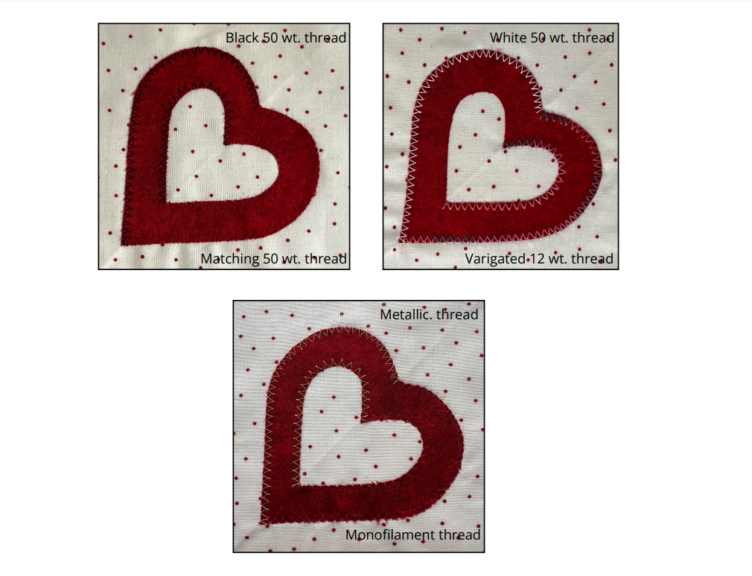Let’s begin with a definition – what is an appliqué?
applique – n. an ornamental needlework in which pieces of fabric are sewn or stuck onto large pieces of fabric to form pictures or patterns
In the world of quilts, there are a variety of ways to achieve this layering of pieces when forming appliqués. The traditional method was to hand stitch the smaller pieces by turning the outer edge to secure them. In later years, the technique of fusing the layers with a thin “adhesive” layer was developed. Quilts with this style of appliqué then needed an edge finish to secure the pieces for laundry and heavy use situations. Which brings us to the topic at hand! What are the stitch options and how are they utilized? Plus, I have some suggestions and samples of a variety of thread choices for today’s quilter
We will go over the following stitches:
- The zigzag
- The blanket stitch
- The satin stitch
- The decorative stitch (of which there are many)
When getting started, stitch style is the first decision to consider. This can also be influenced by the type of thread that is selected. These factors will make a visual impact on the overall finished project. There are no hard and fast rules in appliqué, quilters are free to use the technique and materials that satisfy their artistic intensions!
Zigzag
Traditionally, the most commonly used stitch is the zigzag. The zigzag is very popular because it is easily adjusted to the size and scale of the project. It also is easily accessed by the widest range of sewing machines today. This then, is the stitch of choices for a great number of quilters. Let’s look next at the thread choice and how that impacts the finished appliance of the appliqué. Below are examples of the zigzag with matching thread color. A strong contrasting thread color (black/white) along with a sample of a variegated thread. All options are available to you, but the choice will set a tone for the project. Consider if you want the thread to be a part of the design or if you prefer it to be subtle and more utilitarian in nature.

Selecting a matching thread color secures the appliqué but also allows the shape to have a clean line without any interference. A black thread choice will create a heavy outline to the shape. The white thread on the other hand draws the eye to the outer edge and provides a quite defined edge. The metallic thread adds a bit of Black 50 wt. thread White 50 wt. thread Matching 50 wt. thread Varigated 12 wt. thread Metallic. thread Monofilament thread glimmer and shine to the outer edge of the shape. Lastly, the monofilament can hardly be seen and quietly secures the edge without much fanfare. You decide how you want the edge to appear. Make test samples to audition the thread and stitch width and length.
Blanket Stitch
My go-to finish is the blanket stitch. This stitch is formed with a small stitch into the appliqué and then back in the surrounding fabric, leaving less thread on the actual applique itself, but securing the pieces sufficiently. Some may find this stitch a bit more “folk art” in appearance, but again the thread choice does make a sharp difference in the overall appearance of the design.

Here you can see the blanket stitch using a matching thread which again allows the outer edge to be secured and unobstructed. The use of black thread, white thread and variegated thread each create a different mood and feel to the overall project. Auditioning the thread, stitch width as well as length will aid you in determining the appropriate blanket stitch for your project.
Satin Stitch
In the earliest years of machine appliqué, the satin stitch was the most popular choice. For most designers and quilters, it is still their favorite stitch. This stitch is a densely packed zigzag, that heavily outlines the shape. The appliqué’s outer edge is completely covered and a “thread channel” highlights the individual appliqué shapes. The challenge of this technique is retaining a flat shape. Distortion can happen when stitching along the edges and cause a warped finished project. This Matching thread Black 50 wt. thread White 50 wt. thread Varigated 12 wt. thread can be avoided by using stabilizers on the backside of the project that can easily be removed. There are tear-away styles and wash-away products on the market today. Visit your local quilt shop for additional tips and suggestions on the product that is right for your project.

Decorative Stitches
Sewing machines today have such a wide variety of decorative stitches available to us today, we seldom look to those for inspiration. They too can be utilized in a variety of circumstances to finish or enhance the appliqué shapes. Now, not all stitches will be appropriate, but many could be utilized for a custom, artistic design. Here is an example of a star/snowflake like stitch that adds a bit of whimsy to the appliqué.
Machine applique can be a quick and enjoyable technique, but remember to explore the wide array of stitch finish options. Test the stitch for length and width that is most appropriate for the scale of your project. Remember to consider the wide range of threads available today. That includes thread weight/size from fine to heavy as well as fiber type and thread color. Lastly, remember you are the artist – you direct the viewers eye – be bold in the stitch finish of your creations.
Thanks for sharing these great techniques. I have used a few of them.